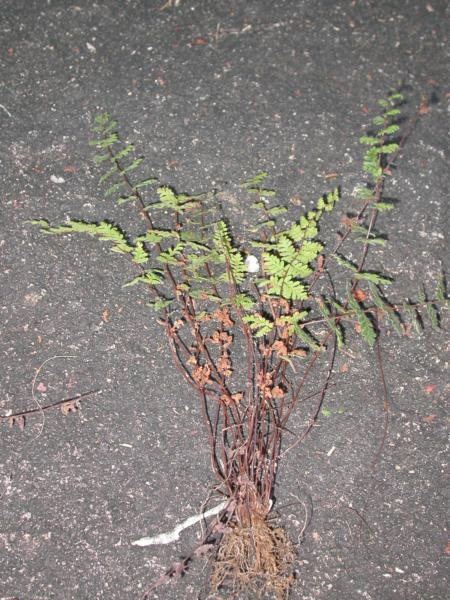
Cheilanthes velutina (Tardieu & C.Chr.) Fraser-Jenk.
Family
Pteridaceae, subfamily Cheilanthoideae
Nomenclature
Cheilanthes velutina (Tardieu & C.Chr.) Fraser-Jenk., New Sp. Syndr. Indian Pteridol. 84. 1997. – Notholaena velutina Tardieu & C.Chr., Not. Syst. 6: 167, f. 5–7. 1938; Tardieu & C.Chr., Fl. Indo-Chine 7 (2): 170. 1940; Tagawa & K.Iwats., Acta Phytotax. Geobot. 23: 50. 1968; Tagawa & K.Iwats., Fl. Thailand 3: 198, f. 15.2. 1985; Boonkerd & Pollawatn, Pterid. Thailand: 101, 123. 2000.
Description
Rhizome short, erect, bearing a tuft of living and older stipes, scaly at apex; scales very narrow, consisting of a few rows of cells, brown to nearly black with paler edges, up to 2.5 mm by c. 0.1 mm. Stipes sparsely scaly in basal part, 7–10 cm long, dark purplish to nearly black, densely pubescent throughout; hairs coarse, light brown, less than 1 mm, gradually becoming shorter upwards. Laminae lanceolate, the apex gradually narrowing, often ending in gemmae, up to 25 by 4 cm, tripinnatifid; rachis grooved on upper surface, dark brown throughout, hairy, gemmiferous; pinnae 1–1.7 cm remote, oblong-subdeltoid, round to moderately acute at apex, truncate to broadly cuneate at base, distinctly stalked; larger ones 2 by 1.5 cm; costa narrowly winged, hairy on both surfaces, rarely gemmiferous and then bulbils 1 or 2 on rachis near apex; pinnules about 5 pairs, narrowly oblong, slightly falcate in larger ones, basal one usually the largest; lobes about 5 pairs, round, entire, strongly revolute, veins free; lamina densely hairy, hairs downy, straight, pale and translucent, 1 mm or so in length. Sori confined to the vein-ending but appearing to be more or less continuous along margin .
Distribution in Thailand
SOUTH-WESTERN: Prachuap Khiri Khan.
Wider Distribution
S Indochina.
Ecology
On dry rocks among ferns in rather dense forests at low altitudes.
Proposed IUCN Conservation Assessment
Least Concern (LC). Although only known from one locality in Thailand this species has a reasonably wide distribution and is not under any known threat.
Notes
This species has traditionally been included in Notholaena. The circumscription of that genus is unclear although it is clear that it is only found in the New World. We, therefore, include this species in Cheilanthes until such a time as the cincumscription of all genera in this group are properly resolved.
Whole plant
Site hosted by the Royal Botanic Garden Edinburgh. Content managed by Stuart Lindsay, Gardens by the Bay, Singapore and David Middleton, Singapore Botanic Gardens. Last updated 24 January 2012
